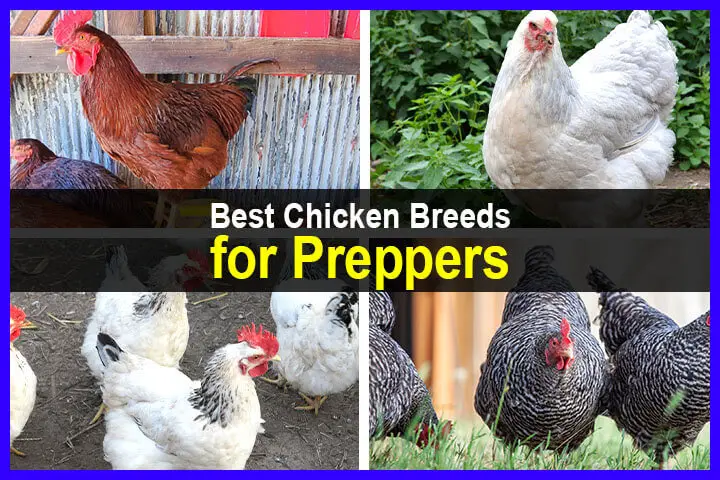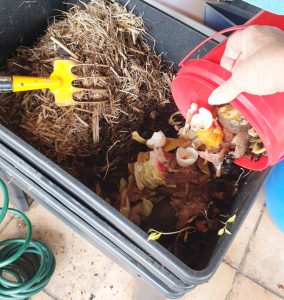Estimated reading time: 13 minutes
Between avian flu outbreaks and supply chain disruptions, the price of eggs skyrocketed over the past year. In February 2023, egg prices were up 70 percent year over year, according to Consumer Price Index data. And even if you were willing to pay that much for the once inexpensive protein sources, you might have had a difficult time finding some on your grocer’s shelf.
Although egg prices have stabilized in more recent months, many consumers are troubled by the ways chickens are commercially raised. If you’ve been thinking about raising your own chickens, you’re not alone.
But what do you need to know to get started? This article provides answers to frequently asked questions on raising backyard chickens, including the best chicken breeds for preppers.
Want to save this post for later? Click Here to Pin It On Pinterest!
Is it legal to raise backyard chickens in my area?

Your first step is to find out about any local ordinances or restrictions on backyard poultry. A good place to start is your city or county website. Some municipalities have rules on the number of birds you can raise, where the coop can be located, and the amount of acreage per bird. Even if your local government allows chickens, your homeowner’s association’s rules may be different.
How much space do I need?

Chickens enjoy space to roam, and your coop must provide protection from predators and the weather. The minimum amount of space you need depends on the breed you intend to raise (see below) and the size of your flock.
Your coop should offer a minimum of three to five square feet per bird, including indoor and outdoor space. A basic coop design has roosts placed over a droppings pit, a daylight window, and screened and shuttered openings for ventilation. You can find a wide array of coop designs — from simple to fancy –online.
For standard-size chickens, here are some minimum space guidelines:
- 6 chickens: 24 square foot coop with 48 square feet run space
- 10 chickens: 40 square foot coop with 80 square feet run space
- 20 chickens: 80 square foot coop with 160 square feet run space.
Heavier breeds require an additional four square feet of coop space per bird and seven more square feet of run space per bird.
Laying hens need nest boxes — one per four to five birds. Chickens also need a place to roost.
What do I feed my backyard chickens?

Healthy, productive chickens require nutritious food and clean, fresh water. A six-pound hen will consume about three pounds of feed each week. That level will increase in the winter as your birds burn more calories to stay warm and decrease in the summer.
Chickens will eat fruits, vegetables, grains, and insects. They will enjoy your family’s fruit and vegetable scraps. A prepared feed will provide them with the vitamins, minerals, and protein they need.
What daily care do backyard chickens need?

Chickens need food and fresh water every day. You’ll need to let them out of the coop each morning and back into the coop each evening at dusk to protect them from predators. You should gather eggs twice a day and clean the coop and outdoor area each week.
Healthy chickens are active and alert and make noises throughout the day. Normal droppings are firm and gray-brown with white urine salts. It is normal for them to have occasional foamy, light-brown droppings.
Chickens have their own distinct personalities, so you’ll get to know when they are acting strangely. Warning signs are wheezing or sneezing sounds or loss of appetite. Here’s more on keeping your chickens healthy.
How do I keep the coop clean?

Raising healthy chickens involves spending time cleaning their environment. The amount of mess and odor chickens produce can be daunting if you are not prepared, and it’s the main reason many experienced folks advise beginners to start small when it comes to the size of your flock.
You should plant to clean and disinfect the indoor and outdoor areas, including feeders and waterers, on a regular basis (or more often as needed).Thorough cleanings help control odor and flies and help reduce the spread of germs that cause disease.
Wearing gloves and a face mask to lower your dust exposure is a good idea. Here is a step-by-step guide on cleaning a chicken coop.
Do I need to have a rooster to have eggs?

Unless you want to increase your flock with baby chicks, you do not need to have a rooster. Hens will lay eggs without a rooster in your coop. However, many experts report that roosters have the following advantages:
- reduce the number of fights between hens
- help the hens find food
- defend the flock from predators
What can I do to protect my chickens from backyard predators?

Chickens that are securely housed within a fenced coop have the least risk. However, if you’d like to raise free-range chickens, you must understand the birds can be in danger from local wildlife both day and night.
Get to know your neighborhood wildlife. Raccoons, weasels, foxes, coyotes, bobcats, and black bears can pose significant threats. Raptors, hawks, and Great horned owls are also a potential concern. Skunks and opossums will want your chicken eggs and sometimes the chickens themselves too.
Free-roaming dogs and cats can be a problem for the safety of your chickens as well. Here are tips for keeping your flock safe. They include burying fence mesh at least one foot deep to prevent predators from digging underneath the enclosure and keeping the surrounding area clear of branches and debris that may allow predators to gain access to your birds.
How many eggs can I expect?

A young hen will begin laying eggs at around six months of age. It will take a while for her to establish a regular laying cycle. However, once her cycle is established, she will lay about one egg per day. Some breeds lay more eggs than others.
Hens need at least 12 to 14 hours of light to lay eggs. Egg production may drop in the fall when daylight hours decrease, and the weather gets colder. You can maintain egg production with artificial lights/heaters, but some experts say this practice can shorten your hen’s number of laying years, so it may be a trade-off. Very hot weather also can affect egg production.
Here’s more information on eggs and egg laying.
What breeds are best for backyard chickens?

Did you know there are hundreds of different chicken breeds? Some are raised for their eggs, others for meat, and still others for their looks or temperament. Some are better suited to colder temperatures than others. So, it’s best to begin your selection process with your goals, your climate, and the amount of space you have in mind.
Here are a few of the best breeds for beginners to consider for their homestead.
Rhode Island Red

The hardy Rhode Island Red typically has an easy-going personality and lays large brown eggs.
Adult hens weigh about 6.5 pounds. These birds do well in small flocks and can handle colder temperatures.
Ameraucana

The Ameraucana is cold-tolerant, friendly, and curious. This breed lays large bluish eggs. Adult hens weigh about 5.5 pounds.
Orpington

The Orpington is a larger breed that lays brown eggs. Adult hens average 8 pounds. Gentle and friendly, the Orpington is a hardy bird that can be raised for eggs or meat.
Plymouth Rock

The friendly Plymouth Rock is another good choice for beginners. Hardy and gentle, this breed produces large brown eggs. Another dual-purpose breed, a Plymouth Rock hen weighs about 7.5 pounds.
Sussex

The Sussex is another hardy chicken breed. Sussex hens, which average about 7 pounds, produce large pale brown or cream-colored eggs. These alert and attractive chickens typically can tolerate the cold and the heat.
Brahma

Despite their large size, Brahma chickens tend to be calm in temperament and, therefore, are easy to handle. Hens average8.5 pounds and lay large brown eggs. They like cool weather and will produce eggs throughout the colder months.
Marans

Marans are a relatively quiet and alert breed, making them a good choice if you live in close proximity to neighbors. They generally are cold- and heat-tolerant and produce dark brown eggs. Hens average about 6.5 pounds.
Silkie

Silkies are docile, attractive, and relatively low-maintenance. Many families enjoy them as pets that also happen to lay eggs. Named for their fluffy feathers, silkie hens are the smallest on our list, weighing only about 4 pounds. They lay cream-colored eggs. However, although the birds tolerate warm weather, they may stop laying in the heat of the summer.
Cochin

Cochins are friendly, gentle giants that also make great pets. Hens average 8.5 pounds and lay large brown eggs. Cochins are a hardy breed and will continue to pay eggs throughout the winter.
Bantam

To be clear, Bantam chickens are not a breed but a set of chicken breeds that are 20 to 25 percent the size of full-size chickens. Bantams are a popular choice for folks who don’t have a lot of space. In general, these mini chickens exhibit the same characteristics as their larger counterparts. However, since they are smaller in size, they produce smaller eggs and may handle temperature changes differently. Here’s more information on Bantams.
Where should I purchase my backyard chickens?

Raising healthy chickens begins with healthy chicks. If you are just starting out on the journey, you may wonder where to get your chicks. Here are some suggestions.
- Hatchery. Make sure you research the hatchery and its practices thoroughly before placing your order.
- Breeders. Look for local breeders who raise the breed of chicken you want to raise. Again, you’ll need to do your research to ensure top quality.
- Swap Meets. Some communities have poultry swap meets. You also may be able to find the supplies you need at these events and do some networking.
- Farm Supply Stores. Some retail outfits have chicks available for purchase. Use caution if going this route, and be sure to find out details about where they are from and how they were raised.
- Neighbors. Have you been buying fresh eggs from someone in your area? Ask them if they have any chicks for sale.
Here are some resources to help you as you prepare for your backyard birds.
Like this post? Don’t Forget to Pin It On Pinterest!



















